2013年8月29日星期四
I Will Tell You A Beautiful Chinese City Kunming
Kunming, capital of Yunnan Province, is known as 'the City of Eternal Spring' for its pleasant climate and flowers blooming all year long. With a history of more than 2,400 years, it was the gateway to the celebrated Silk Road that facilitated trade with Tibet, Sichuan, Myanmar and India. Today it is the political,
economical and cultural center of Yunnan as well as the most popular tourist destination in southwest China.
The city enjoys a pleasant climate and does its best to live up to its title of 'the City of Eternal Spring'. Whenever you are planning to go, the temperature is always pleasant. With its convenient transport links in and out of the city, Kunming welcomes and sees off tens of thousands of visitors every day.
For first-time visitors, Kunming city center is an attraction with its two squares and five interlaced roads - Jinma Biji Square, Dongfeng Square, Dongfeng Lu, Jinbi Lu, Zhengyi Lu, Renmin Lu and Qingnian Lu, among which Jinbi Square has the most eye-catching architecture. Qingnian Lu, Zhengyi Lu, and Renmin Lu are the main commercial areas; the most popular pedestrian streets are Nanping Jie, Jingxing Huaniao Shichang, and Jinma Biji Fang.
2013年8月25日星期日
Noodle Yes She is "za jiang mian"Beijing
If you are craving some authentic Beijing cuisine, look no further than the Haiwanju Restaurant with its Black Bean Sauce Noodles of old Beijing, a daily necessity for Beijingers. This restaurant, of typical Chinese style, serves traditional food in a lively Old Beijing atmosphere.
The restaurant's decor is that of a simple eatery in Beijing with wooden tables and pews. The menu is not offered in English which necessitates that some customers may need to point to pictures on the menu or to what other diners are eating. The servers, dressed in either red or blue, are efficient and considerate. They shout across the room to announce customers arriving and leaving. Staple dishes like traditional Beijing-style "za jiang mian" (noodles with black bean sauce) and boiled dumplings are not to be missed. The handmade noodles are topped with vegetables and salty bean and pork sauce. This is hearty, traditional food and can really fill you up and ward off the sharp northern wind during the winter.
Recommended noodle: noodles with black bean sauce
Other recommendations: Beijing style sausage; boiled hawthorn with syrup and honey.
2013年8月22日星期四
Sanjianfang Have You Ever Been There ?
A few miles away from Gaobeidian, there is an antique furniture street not known to ordinary people-Sanjianfang. If it is the first time you come here, you can hardly find this so-called furniture market unless you make quite a few swerves. Fortunately, there stands a line of red-painted two-storey Chinese style
storehouses with green eaves. Upon inquiry, you will find dozens of fairly big workshops to collect and process antique furniture at Sanjianfang.
They are fairly big because almost every workshop has several large warehouses. Behind any one of these shabby gates is an astonishing scene: thousands of pieces of antique furniture are packed up in a limited space of several hundred square meters. That scene reminds you of the US-style warehousing marketing.Before long, antique furniture fans will find a brand-new Sanjianfang Antique Furniture Market. Then they need not wander around to explore the hidden treasure island, but go straight to their favourites!
2013年8月21日星期三
Gaobeidian Antique Furniture Street The Preferential Benefit Furniture Market
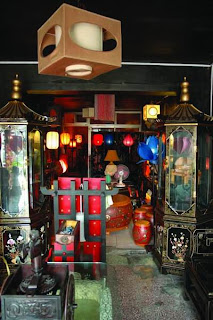 For many modern people, getting to IKEA and buying a few stylish furniture, has become quite out of date itself. Instead, to explore ancient furniture markets, coming across some genuine classics, is a far more attractive way to return to Homeland, and to take some solace from traditional culture.
For many modern people, getting to IKEA and buying a few stylish furniture, has become quite out of date itself. Instead, to explore ancient furniture markets, coming across some genuine classics, is a far more attractive way to return to Homeland, and to take some solace from traditional culture.The antique furniture street in the thousand-year-old village Gaobeidian, is a typical "creativity fair" that can easily make tourists linger on with no thought of leaving. It is creative because the street has not stay at the preliminary stage of selling or imitating traditional classic furniture , but has developed many imaginative designs by blending traditional styles with modern day trends, such as the concept of "new make of old wood" or even the idea of neoclassicism. It is a fair because this is a genuine village market, gathering dozens of workshops of different types along the 1500-meter long street, all with small fronts and deep backyards.
2013年8月15日星期四
Taste Qingfengbaozi if You Come to Beijing
An old brand name in Beijing, this restaurant features baozi stuffed with three fillings: lean pork, mushrooms and shelled shrimp. The baozi here are big. Qingfeng Steamed Stuffed Bun Restaurant was originally named Wan He Jv in 1948 Qingfeng Steamed Stuffed Bun was rated as a unique snack in Beijing. It has been one of the Beijingers most popular old eateries for decades.
when it was opened. Later, the restaurant specialized in steamed stuffed buns and changed its name to Qingfeng. In 1988,
Today, Qingfeng Steamed Stuffed Bun Restaurant is decorated in a simple, clean style. Outside the restaurant, Chinese red lanterns serve as a sign. Looking through the clean windows, you will see many employees in white sitting around a table in the kitchen and wrapping up the buns while some customers sit in the restaurant enjoying their delicacies.
After entering the restaurant, some patrons stand in line waiting to order their meals. On the far side, many rectangular tables and stools wait in rows for occupants. On one wall, food items and prices are on display. On the opposite wall, there are two large pictures depicting old Qingfeng scenes.
2013年8月11日星期日
Beijing Folklore Museum
This museum is a place of interest which stores the treasures of folk-customs of Beijing. Situated in the Dongyue Temple, a cultural site under the first-class protection of the state, the museum is composed of grand and exquisite buildings which look especially spectacular.
Since it opened to the public in 1999, the museum has put on exhibitions characterized by distinctive folk styles. Such exhibitions include: the Beijing Folklore Exhibition, China's Centenary Folk Costume Exhibition, Old Beijingnese Life Exhibition, Etiquette and Custom Exhibition and Pouch Collection Exhibition. These exhibitions all enjoy great popularity among the people of Beijing.
The folk cultural activities along with the festivals also attract many visitors to the museum. The activities like "walk the blessing road, round the blessing tree, draw the blessing cloth, and tie the blessing ribbon" under the theme of "pray blessing and carry the blessing home" have become famous ceremonies to celebrate the Spring Festival in the capital.
2013年8月8日星期四
Kaorouji in Beijing is a Local Famous Food Restaruants
As a "Famous Chinese Old Brand" and one of the largest Muslim restaurants in Beijing, the Kao Rou Ji Restaurant is located at the north riverbank of the renowned tourist attraction : Qianhai, Shichahai. It is beside the Yinding Bridge (Ingot Bridge) and adjacent to the Bell Tower.
Founded in 1848, having undergone a development of over a hundred years and especially as a result of its renovation in 1995, Kao Rou Ji has grown into a famous restaurant specializing in, among others: Muslim dishes, Gualu Roast Duck and Beijing cuisine specialties such as Beijing flavor grilled lamb and beef. Grilled meat dishes here are best known for their exquisite processing, elegantly mellow flavor, freshness and tenderness as well as the strict selection process.
Recommended: mince chicken and sea cucumber, fried prawns, braised pork, grilled mutton, stir-fried lamb with dried apricot slices, sweet fruit roll, etc.
2013年8月5日星期一
The Peking University Gymnasium in Beijing
The Peking University Gymnasium (PKG), to be used for the Table Tennis events of the Beijing Olympics, was inaugurated recently.
It is the first time that the Olympic Table Tennis competition will be held at a venue dedicated to the sport.
Table tennis was listed as an Olympic sport in 1988 at the Olympic Games in Seoul, and since then, the competition has shared the venues used also for other Olympic competitions for five consecutive Olympics.
Located on the Peking University campus and covering an area of 26,900 sq m, the gymnasium includes a natatorium and is 122.6 m long from south to north and 87.7 m wide from east to west. The table tennis venue on the first floor is 47 m long and 39.5 m wide, has room for eight competition tables, and can seat 7,557.
The project's steel structure relies on a seven-part support system comprising a pre-stress inhaul cable and horizontal, vertical, and other supportive components. Its roof resembles a table tennis ball between two hyperbolic surfaces, garnering it the name "China Ridge."
2013年8月1日星期四
Want to Have a Tour This Summer ? Lianquanxianggu Natural Scenic Spot
Lianquanxianggu Natural Scenic Spot is located at the foot of the Great Wall in the northwestern Huairou District, in front of Heituo Mountain, and 80km away from Beijing. There are waterfalls pouring down from the Heaven and springs babbling along the valley, where sounds of waterfall and springs echo each other,
that is why it is called the "Lianquanxianggu" (waterfall & echoic valley). The Lianquanxianggu boasts verdant hills and green water, perilous peak and ravine, joyous spring and flying waterfall, heavy forests and remote caves, unique mountains and rocks, as well as 3??-5?? lower temperature than that in downtown. It has such main landscapes as Thien Cung Cave, Maotou Hill, three-pool and two-waterfall, reed and valley of loneness, glacier in May, turtle of longevity, primitive second forest, etc.
Also, some service facilities are provided, inclusive of quadrangle dwellings, Mongolian yurts, small wood houses, restaurants, stores, hot spring hotels and karaoke bars. Tourists can enjoy flowers and grasses on mountains in spring, natural landscapes in summer, red leaves in autumn and natural ice waterfall in winter. Meanwhile, they can fish red trout, go for a picnic, have a barbecue, and hold a bonfire evening.
that is why it is called the "Lianquanxianggu" (waterfall & echoic valley). The Lianquanxianggu boasts verdant hills and green water, perilous peak and ravine, joyous spring and flying waterfall, heavy forests and remote caves, unique mountains and rocks, as well as 3??-5?? lower temperature than that in downtown. It has such main landscapes as Thien Cung Cave, Maotou Hill, three-pool and two-waterfall, reed and valley of loneness, glacier in May, turtle of longevity, primitive second forest, etc.
Also, some service facilities are provided, inclusive of quadrangle dwellings, Mongolian yurts, small wood houses, restaurants, stores, hot spring hotels and karaoke bars. Tourists can enjoy flowers and grasses on mountains in spring, natural landscapes in summer, red leaves in autumn and natural ice waterfall in winter. Meanwhile, they can fish red trout, go for a picnic, have a barbecue, and hold a bonfire evening.
2013年7月29日星期一
Have You Ever Been to Guijie ?
Guijie (Ghost Street).Located in Dongzhimen, Guijie is an essential part of life for Beijing citizens. Despite that fact that
life here is colorful and peaceful in daytime and at night, far from being gloomy and scary, many ghost stories can be heard from the old timers. According to them, the name Guijie originated from Gui(鬼)jie(街), meaning a street haunted by ghosts; there were many shops selling coffins here with few shoppers several decades ago; business prospects seemed to be dimming since 1997, when the real street of catering came into being, thus spreading its name as a street haunted by ghosts.
life here is colorful and peaceful in daytime and at night, far from being gloomy and scary, many ghost stories can be heard from the old timers. According to them, the name Guijie originated from Gui(鬼)jie(街), meaning a street haunted by ghosts; there were many shops selling coffins here with few shoppers several decades ago; business prospects seemed to be dimming since 1997, when the real street of catering came into being, thus spreading its name as a street haunted by ghosts.
2013年7月22日星期一
Going to the Great Wall, and Becoming a "Real Man"
My first encounter with the Great Wall was here. Its size, its beauty, the
setting and the spectacle of its history made me and everyone I was with fall silent as we approached. Standing on top of the Wall for the first time was awe inspiring. It would be a marvelous feet to build this by today's standards, but while up there I began to think about the people who built this wall so very long ago. Without today's technology it must have been very arduous and dangerous work. Keeping out the barbarians from the north, the Chinese people sacrificed their bodies, their blood, sweat and tears to make this wall. My friend Kyle summed up our mood when he said "You gotta give them this, the Chinese have done something amazing here!" And he was absolutely right, they had.
setting and the spectacle of its history made me and everyone I was with fall silent as we approached. Standing on top of the Wall for the first time was awe inspiring. It would be a marvelous feet to build this by today's standards, but while up there I began to think about the people who built this wall so very long ago. Without today's technology it must have been very arduous and dangerous work. Keeping out the barbarians from the north, the Chinese people sacrificed their bodies, their blood, sweat and tears to make this wall. My friend Kyle summed up our mood when he said "You gotta give them this, the Chinese have done something amazing here!" And he was absolutely right, they had.
2013年7月16日星期二
Fun Things to do in Beijing at Summer Night
Things to do in Beijing Night - Qianmen Street

Things to do in Beijing Night - Solana
Things to do in Beijing Night - The Palace
Things to do in Beijing Night - Tiananmen Square
Things to do in Beijing Night - Water Cube
Things to do in Beijing Night - Bird’s Nest
Things to do in Beijing Night - Guomao Area (China World Trade Center Tower III)
Things to do in Beijing Night - Old CCTV Tower
Things to do in Beijing Night - Acrobatics Show
Things to do in Beijing Night - Peking Opera Show
Things to do in Beijing Night - Kung Fu Show
2013年7月12日星期五
Temple of Heaven - A symbol building of Beijing
Once I thought that the Temple of Heaven is just the place for emperors to worship the heaven so besides the main hall there won't be any other attractive places deserve to visit. However I was completely wrong after personally visited there. And I would like to share my experience in the Temple of Heaven to the other attractions except the three main buildings – the Hall of Prayer for Good Harvest, Imperial Vault of Heaven and Circular Mound Altar.
Actually the Temple of Heaven now has become a big park. Also in order to let tourists feel easier to visit, every entrance of the park offers the electronic tour guide (Chinese cost 10 Yuan and foreign languages cost 40 Yuan). If you are traveling all by yourselves it will help you a lot during the tour. I entered through the East Gate and got the view of the main hall – the Hall of Prayer for Good Harvest, beautiful. Walking towards it, on the right side there is a big square for people to do exercises. On the ground there set different kinds of exercise equipments and hundreds of people playing there during the day time. Some are playing Taichi Ball, some are dancing, some are playing shuttlecock, so happy. They were all very friendly and invited me to join them.
Went on the journey I saw a lot of people sitting on the gallery crocheting small things including hats, bags, purse and little animals, so lovely. Hiding from the bright sunshine, I bought a hat for 35 Yuan, beautiful! This gallery is called "72 Long Gallery". Why got this name since it is not very long actually? This is because it has 72 gaps. The decorations and the color are all very simple and elegant, symbolizing the serious atmosphere of the sacrifice. This gallery is the road to the Hall of Prayer for Good Harvest.
Went on you will find the Cypress Forest and the Flower Garden. On both sides of the clean road setting chairs for tourists to have a rest. Sitting on the chair, with gentle breezing, green trees, relaxed! In Cypress Forest there planted the old trees with hundred years history. In the garden there plant different kinds of flowers including peony, the Chinese rose and others I did not know the name. During the period of midsummer, here will be the flower sea. Never miss the beautiful scenery in the garden during your tour of the Temple of Heaven.
Resource:http://www.beijinglandscapes.com/beijing-travel-blog/beijing-temple-of-heaven.html
2013年7月10日星期三
Learning Chinese Cooking by Travelling in Hutong
I'm very interested in Chinese food and Chinese cooking. Surf the internet and look for Beijing tour routes. "Beijing Cooking Learning Tour", oh that's what I want! Online book the tour directly.
It's the time for the trip. At 9:00 am the English speaking tour guide picked me up from my hotel and drove to Beijing Cuisine School. Oh, how beautiful dishes! In the cooking school I learnt cooking three different dishes from beginning to end, getting to know the secrets of excellent Chinese culinary skill. The experienced expert of the school told me how to prepare the dish and the steps of cooking. I feel it very different. Thanks to the expert's help, after about two hours I finally finished the three dishes. I still couldn't remember the names of the three dishes, but enjoy the three dishes as my lunch I felt very happy and satisfied though the taste is a little bit strange.
My Lunch
After lunch, the tour guide drove me to a local vegetable market in the downtown area where local community people come for purchasing vegetable, meats, the many spices and other life necessities that make Chinese cooking special. There I saw many local citizens buy the vegetables. Then we move okn to one of the branches of the century-old traditional Daoxiangcun Foodstuffs Store. The store used to produce light snack served to the royal family or governmental officials in the Qing Dynasty. Now it has become one of the local people's must-have snacks of Beijing. The dessert here looks both delicious and delicate, so I bought six boxes for my friends to have a taste.
The tour finished in the early afternoon. I'd like to walk around to see local Beijing life. Once heard that there is a famous Hutong called Nanluoguxiang, where have many local snacks, different kinds of special shops and bars, so in the afternoon I went there. It deserves the reputation! Nearly 1000 meters long Hutong stand so many special shops and bars. There I bought a T-shirt with the design of the Peking Opera mask.
Today I really have a nice trip of "Beijing Cooking Learning Tour" which I did learn a lot of Chinese food. Also the trip to Nanluoguxiang gave me a deep impression.
Resource:http://www.beijinglandscapes.com/beijing-travel-blog/cooking-learning-tour.html
2013年7月5日星期五
Essence Tour of Beijing - Follow the Steps of Hutong
When the traffic jam, vehicle exhaust and no parking lot affect the convenient and mood of driving, bike, the once outdated transportation media, nobly become the favorite choice of trip and leisure under the call of low-carbon lifestyle.
Low-carbon times, riding bike for trip is an ideal choice. No matter the locals or guests, prepare or rent a bike to visit the hutong in inner of Beijing in leisurely time, you will have better feelings. Parking in the front of some interesting shops, choosing the wonderful goods or taste the local snacks, you are harvest enough in this special Beijing tour. Follow us quickly!
Beijing, the gathering place of hutong, has various famous and non-famous hutongs. The composition of chess game and the laugh of aunts are the sceneries in hutongs forever. In the courtyards of hutongs, always there are old trees and do not know how old they are, may be the jujube tree, cypress or Chinese scholar tree. When the sun is shining brightly, aged people talked with each other and kids playing around this tree. I guess, it is happiness for most of ordinary people.
Start from North Street of Dianmenwai, you can visit the Drum and Bell Tower first. Walking south along with the Drum and Bell Tower, you will find the Yandaixiejie, the oldest oblique street in Beijing, located at north of Dianmen, about 230 meters in length. You could not belittle the short street, it gathers various characteristic shops, restaurants and wine bars. They decorate this street livelier.
Out of Yandaixiejie, it is the famous Yindingqiao Bridge. It is said that you can see the distance Xishan Mountain in fine day. That is one of the Yanjing Eight Scenes. Pass the Yindingqiao Bridge, you should have good time among hutongs in Shi Cha Hai area. Built depend on the terrain, these hutong is natural. Anyone courtyard here, you could find the historical site easily.
Riding the bike, you are leisurely in lively hutongs, to enjoy the sunshine and strong Beijing culture in the air, and surrounding your soul.
Wandering in these hutongs, you are lucky to find many interesting things and delicious tastes. Just walking and wandering, you have good time in afternoon of Beijing…
Resource: http://www.beijinglandscapes.com/beijing-travel-blog/essence-tour-of-beijing-1.html
2013年7月3日星期三
Things to do in Beijing - Beijing Bus Day Tour
A lot of things to do in Beijing that you should not be miss. Among many interesting thing to do in Beijing, we will suggest this one trip that will bring you to explore the old and modern Beijing in one day. Some tour detail below:
Departure: Daily
Tour Duration: about 8 hours include lunch
Pick-up place and time: Your City Center Hotel about 8:00am
Finishing place and time: Your City Center Hotel around 5:00pm
Payment Method: Cash, Credit Cards, Wire, Western Union
Tour Guide Language: English
Feature: One day group tour presents Hutong, Lama Temple, Panda Zoo and the Olympic Stadiums. Experience the modern and ancient Beijing beauty during short journey with considerate service.
Detail Itinerary:
1.Pick up at your hotel between 7:20am and 8:30am, and then drive to Beijing Zoo first, for about 40 minutes visiting you can see the lovely Giant Pandas.
- Beijing Zoo: China’s and World’s largest treasure house of animals and birds, also there are pandas.
2. After visiting the Panda House, move on to the Lama Temple. 1 hour tour for the mysterious Tibet style Buddhism temple finishes at about 11:00am. Then, you will have 45 minutes to visit the Chinese traditional handicraft silk carpet factory. After that, you will be arranged to have lunch with locals in a typical Beijing resident’s house at 12:00.
- Lama Temple: The largest and most perfectly preserved lamasery of Gelug Sect in present day Beijing.
3. After lunch, you will be arranged to visit the old Beijing lanes by rickshaws. During 2 hours hutong tour, you will visit the typical Chinese quadrangles, primary school and many famous old buildings, where you can explore the real life of ordinary people in Beijing.
4. Next destination is the Olympic Stadium where you have 45 minutes to take pictures outside the Bird’s Nest and Water Cube. If you are interested in the inner structure, the tour guide will help you in purchasing the entrance tickets, and you could have the inner visit on your own.
5. On the way to your hotels, we also arrange a short visit to a China Tea House for you to enjoy tea ceremony. Transfer back to your hotels, tour end.
Price including:
1. Pick-up and drop off service from your hotel;
2. Air-conditioned vehicle van;
3. Entrance tickets of sightseeing;
4. Driver and English speaking tour guide explain the sightseeing about the tour;
5. A typical Chinese lunch.
Price excluding:
Tips to the guide and driver.
Resource: http://things-to-do-in-beijing.com/1-day-hutong-lama-temple-panda-house-olympic-stadiums-bus-tour/
2013年7月1日星期一
Different Sections of Great Wall Sightseeing in Beijing
No visit to the Great Wall seems you did not visit Beijing. I decided to have a Great Wall tour to explore the fact of the Great Wall. This passage is for reference only.
First arrived at the most famous section – Badaling Great Wall. Badaling Great Wall is the most well-preserved section, also the most representative section, the essence of the Great Wall in Ming Dynasty. At same time, if you have visited other sections of the Great Wall, you will discover this section is well-maintained by government, and opened as the tourist part for travelers. The Great Wall at Badaling is the advanced guard of Juyongguan Pass, the important pass of the Great Wall. With the height of 1,015 meters, this section is strategically located and difficult of access and is the outstanding of the Great Wall. With superior geographic location, Badaling Great Wall is the important transportation for Shanxi Province, Inner Mongolia and Zhangjiakou City. Badaling Great Wall was listed into the World Cultural Heritage and one of the Seven World Wonders.
Second, the Mutianyu Great Wall, located at Huairou District of Beijing, 73 kilometers from Beijing downtown. The Great Wall at Mutianyu connects the Juyongguan Pass in west and Gubeikou Great Wall in east, which is the military pass since ancient times. Now it is one of the most well-preserved sections of the Ming Great Wall. The right seasons for the Great Wall at Mutianyu include spring, summer, autumn and winter. Different time, you will enjoy different feelings of the Great Wall. In spring and autumn, the view of Mutianyu is always attracts large number of tourists. The winter of Mutianyu is famous for its scenery of snow, but bad weather is not fitful trip.
Third, the Hanghuacheng Great Wall, famous water Great Wall, was built in Yongle Emperor of Ming Dynasty with 600 years history. After capital was built in Beijing by the Emperor of Ming Dynasty, and tomb was built in north of Huanghua Town, the Great Wall is not only guarded the north gate of Beijing, but also protected the Ming Tombs. Huanghuacheng Water Great Wall is shaped by the river dam result in the water level higher, so the lower section was flood in the water. This is unique scenery in sections of the Great Wall. Huanghuacheng Great Wall is the only one Great Wall has three sections in water in China.
Above is my exploration to three sections of the Great Wall, according to your needs and like, choose the fitful section to enjoy the scenery of the world famous Great Wall. It is only three sections, if you like, you can visit more sections of the Great Wall, you will find more interesting things and views.
Article Resource : http://www.beijinglandscapes.com/beijing-travel-blog/sightseeing-different-great-wall-in-beijing.html
2013年6月26日星期三
Top 10 Fmous Snacks in Beijing
Filled sausage (灌肠)
Fried beef tripe (爆肚)
Fried wheaten pancake with fillings (褡裢火烧)
Mung bean milk (豆汁)
Rolling donkey (驴打滚)
Steamed rice cakes with sweet stuffing (艾窝窝)
Stewed pork liver (炒肝)
Stir-fried starch knots (炒疙瘩)
Sweet ears (糖耳朵)
Wheaten cake boiled in meat broth (卤煮火烧)
Fried beef tripe (爆肚)
Fried wheaten pancake with fillings (褡裢火烧)
Mung bean milk (豆汁)
Rolling donkey (驴打滚)
Steamed rice cakes with sweet stuffing (艾窝窝)
Stewed pork liver (炒肝)
Stir-fried starch knots (炒疙瘩)
Sweet ears (糖耳朵)
Wheaten cake boiled in meat broth (卤煮火烧)
2013年6月23日星期日
Top 10 Tourist Attractions & Things to Do in Beijing
If you understand a little bit about Beijing, you would not puzzle what to do during Beijing tour. Here I am so
glad to tell you what most tourists do in Beijing.
Explore
Hutong
Hutong presents a window into a traditional
way of life intertwined with the old architecture and maze of narrow streets.
It is not only the most represent the old life of Beijing but also a unique gem of Chinese
culture.
Both from the historical and the personal
perspective, Beijing Hutong is understandably attracting more and more overseas
visitors.
See Breathtaking
Performance- Peking Opera
Contains the soul of Chinese national
culture, Peking Opera is a national treasure with a history of over 200 years
and it has a deep influence in China.. Its unique charm inspires deep feelings
in Chinese people.
Beijing Opera uses a combination of
stylized actions like singing, dancing, dialogue and acrobatic fighting to tell
a story or present different characters and their happiness, anger, sorrow, surprise,
fear and sadness.
Taste
Beijing Roast
Duck
Has been prepared since the Yuan Dynasty, Beijing
Roast Duck is now considered as one of China's national foods.
I do know whether you heard of a saying
like this" there are two things you must do in Beijing, to eat the Beijing Roast duck and to
see the ten thousands miles long Great wall." As a famous duck dish,
Beijing Roast Duck is prized for the thin, crispy skin, with authentic versions
of the dish serving mostly the skin and a little meat, sliced in front of the
diners by the cook. So Beijing Roast Duck you'd better have a try during your Beijing tour.
Enjoy
Local Snacks

With strong local flavors, the snacks in Beijing are as numerous
as they are tasty. Beijing
has a time-honored history of producing various kinds of snacks.
From porridge to stuffed sausage, you will
undoubtedly find several of your own personal favorites as you eat your way
through some famous snack street or famous snack restaurants.
Walk
through Panjiayuan Market

Panjiayuan Market is the largest antiques market
among its kind both in China
and Asia. It is really a market for everybody
to come, even Hilary Clinton has shopped here.
All kinds of souvenirs are available for
sale, including paintings, calligraphy, ceramics, jade, furniture, coins, army
surplus, "cultural revolution" memorabilia, Buddhist artifacts and
much, much more.
So which one do you want to have a try
during your Beijing tours, or all of them?
2013年6月19日星期三
Top 10 Things to do in Beijing
For centuries, the city's hulking official buildings served as reminders of the awesome power of the imperial state. That didn't change much when the Communist government took over in 1949. Then, with the reform and opening of China, which began some three decades ago, the new elite — corporate chieftains and their bureaucratic allies — began erecting capitalist monoliths to showcase their newfound wealth and influence. There's a lot of architectural swagger in Beijing, but between and behind it there's also a lot for the tourist to enjoy.
At the physical and metaphorical center of Beijing is the Forbidden City, the vast palace complex of former emperors that is now one of the greatest museums in the world. From here, most of the city's other major sites — except, of course, the Great Wall — are within a radius of a mile or two.
1. Emperor Hotel Bar
The boutique Emperor Hotel is perched just opposite the east gate of the massive Forbidden City palace complex. Trendy and airy, the 55-room hotel has many charms. But best of all for the weary traveler is its rooftop bar, Yin. Built on an ascending series of platforms, the bar has the best view in town hands-down. Having a drink here at dusk as you gaze over the swooping tiled roofs of the vast former residence of the Emperor is magical. A word of warning, though: Presumably in the spirit of adding Chinese authenticity, many of the house cocktails are made with the notoriously potent Chinese rice liquor baijiu. Avoid those.
- 1. Emperor Hotel
33 Qihelou Street, Beijing, China 100006; 86-(0)10-6526-5566 - 2. Yin, Emperor Hotel Rooftop
33 Qihelou Street, Dongcheng, Beijing, China 100006; 86-(0)10-6526-5566
2. Shichahai Lakes
Everybody visits the Forbidden City, of course, but a stroll around the adjoining lakes, which used to be part of the emperors' vast pleasure gardens is a wonderful complement. Don't pass up renting a rowboat and taking a float around Beihai (or North Lake) Park, while contemplating the huge white Buddhist stupa built in 1271 by Kublai Khan. The three lakes — Qianhai (Front Lake), Houhai (Rear Lake) and Xihai (West Lake) — north of Beihai and about a mile north of the Forbidden City are known collectively as Shichahai and are ringed by restaurants and bars. Try the wildly popular cuisine of the Hakka minority group at Han Cang on the Shichahai East Bank.-
1. Forbidden City
Palace Museum, Beijing -
2. Beihai (North Lake) Park
Beijing, China; 86-(0)10-6407-1415 - 3. Han Cang
Shichahai East Bank, Opposite north gate of Beihai Park, Beijing, China; 86-(0)10-6404-2259
3. Hutongs
After a stop for refreshment in Shichahai, head east on Guloudajie Road into one of Beijing's few remaining hutong neighborhoods, with narrow alleys and single story traditional courtyard houses. Hutongs once dominated the city, but in recent years many have been leveled in the name of modernization. Trishaw drivers hang around offering tours, but a better and cheaper (not to mention healthier) bet is to rent your own bike and get pleasantly lost in the back lanes around the Drum and Bell towers. It's not hard to find one of numerous small bicycle shops nearby. Alternatively, look for one of 20 stands dotted around the city, run by the Beijing Bike Rental Company, which rents bikes by the hour, the day or longer.
1. Drum Tower and Bell Tower
Gulou Xidajie, Dongcheng, Beijing, China
4. Nanluoguxiang
If you're keen on retail therapy, one must-see hutong is Nanluoguxiang in the Gulou, or Drum and Bell Tower, district, which has several kilometers of shops, galleries and cafés that range from the chic to the kitschy. You'll find lots of cool T-shirts here (Plastered has a good line) featuring tricked-out images of everything from Mao Zedong to garden gnomes. Fun.
- 1. Plastered T-Shirts
61 Nanluoguxiang, Beijing, China 100009; 86-(0)134-8884-8855
5. Dali Courtyard Restaurant
Recharge from shopping in Nanluoguxiang at nearby Dali Courtyard Restaurant, a beautifully restored, laid-back place — it's not gussied up to a fake plastic sheen — that specializes in the food of the southern province of Yunnan. Influenced by the dishes of its Southeast Asian neighbors, Burma and Vietnam, Yunnan cuisine is light and sophisticated, and makes good use of the region's abundant mushrooms and unusual herbs. There is no menu at Dali. Diners enjoy price-fixed courses between US $15 and $40, made from whatever the chef found freshest in the market that day. The place is a little tricky to find. Your taxi will drop you at the mouth of the alley; walk straight down about 150 yards and look to your left for a red lantern down an even smaller alley.
- 1. Dali Courtyard Restaurant
67 Xiaojingchang Hutong, Beijing, China; 86-(0)10-8404-2030
订阅:
评论 (Atom)

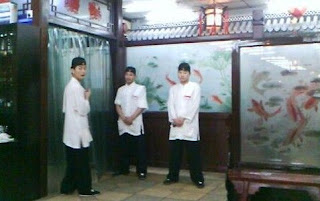
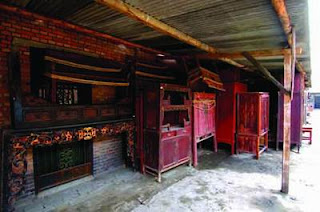
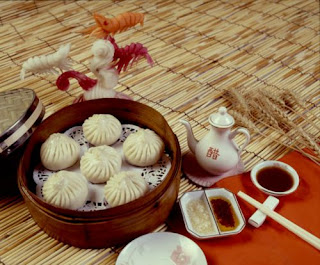
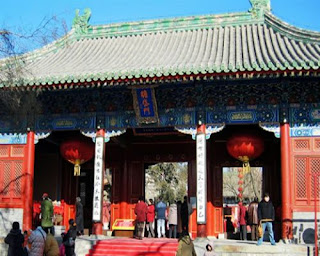
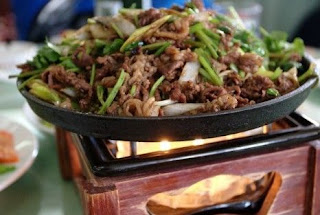

















.jpg)













